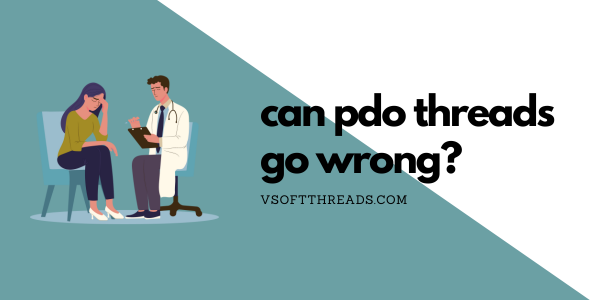
People all around the world are turning to PDO threads to give their faces and their skin amazing rejuvenation and the “lift” they need to look the way they want. One of the biggest benefits of this procedure over a traditional facelift is the fact that it is a non-surgical, minimally-invasive procedure.
In most cases, PDO threads procedures will take less than an hour and don’t require the extensive downtime and recovery processes as facelifts. A licensed practitioner will simply numb the area that’s being treated, insert very thin threads into the skin, and the procedure will be completed.
Those who haven’t tried a PDO threads procedure yet might naturally be concerned about what could go wrong during the procedure. We’ll discuss a typical PDO threads procedure, some of the rare ways that it could go wrong and what you can do about it.
Experts consider PDO threads procedures to be very low risk.1 That being said, there are some potential complications that could arise, as with any procedure. This includes more serious bruising and swelling, pain and/or discomfort, sensitivity to light, bleeding, and difficulty moving the area that has been treated. Most of the time, these effects will correct themselves in just a few weeks, and aren’t a major cause for concern.
Table of Contents
Add a header to begin generating the table of contents
 Medically reviewed by: Elizabeth Williams RN
Medically reviewed by: Elizabeth Williams RN
Updated: 7/3/2024
What Does a PDO Threads Procedure Entail?
PDO threads are surgical sutures that are inserted into the skin. They are dissolvable, meaning that they do not need to be removed once they are inserted since your body will break them down naturally.
These threads have actually been used in surgical procedures for many years, but only started being used commonly in aesthetic medicine procedures in the last 30 years or so.
The PDO threads come pre-loaded into what are cannulas. This makes it easier for the practitioner to insert them to produce the exact desired results that you want.
Some threads have barbs on them, which grip parts of the skin when inserted and lift them up. These are often used in problem areas such as around lips, on necks and cheeks, and under eyes to give parts of your face a more defined and youthful look.
And speaking of youthful look, PDO threads give your skin that youthful glow because they help to stimulate the production of collagen. When the PDO threads are inserted into your skin, your body recognizes the foreign substances and begins to produce extra collagen to break them down.
This results in the effects of the procedure lasting longer, and gives your skin a smoother, shinier look that many people desire.
There’s no need for general anesthesia with a PDO threads procedure. Instead, your practitioner will numb the area that is going to be treated before inserting the threads.
In total, the procedure will likely take less than an hour from start to finish.
What is the Downtime and Recovery Time of a PDO Threads Procedure?
A major reason why an increasing number of people are turning to PDO threads procedures is the minimal downtime and recovery time. In most cases, you will be able to resume your normal daily activities immediately after the procedure is complete.
Learn more about PDO Threads Aftercare
It’s often advised that you avoid strenuous exercises for at least a few weeks following the procedure, as well as any deep tissue massages or facials in that same time period. All of those activities could risk moving the threads out of their place.
The most common after-effects of a PDO threads procedure are minor bruising and swelling. This can typically be treated with over-the-counter anti-inflammatory medications as well as ice and general rest.
Generally speaking, any bruising and swelling you experience should dissipate in the one to two weeks following the procedure.
What Can Go Wrong with PDO Threads?
Experts consider PDO threads procedures to be very low risk.1 That being said, there are some potential complications that could arise, as with any procedure.
This includes more serious bruising and swelling, pain and/or discomfort, sensitivity to light, bleeding, and difficulty moving the area that has been treated.
Most of the time, these effects will correct themselves in just a few weeks, and aren’t a major cause for concern.
However, if you experience any of the following symptoms and/or side effects after your procedure, then you should immediately contact the practitioner who did your PDO threads procedure:
- Fever for more than 24 hours
- Intense swelling for 48 hours or more
- Recurring headaches
- Any discharge at the site of the treatment
Can You Minimize the Risks of PDO Threads?
A major question that patients have is if there’s anything they can do to minimize risks of a PDO threads procedure. The answer is, yes.2
Some things you can do include:
- Notify your practitioner of supplements or medications you take.
- Don’t take any blood thinners or NSAIDs such as ibuprofen for one week prior to your procedure.
- Don’t drink alcohol for at least 24 hours before the procedure, and don’t smoke for one to two weeks before.
- Limit the amount of inflammatory “triggers” you consume leading up to the procedure, including sugar and caffeine.
Work with a Reputable Practitioner Who Uses V Soft Lift Threads
Of course, one of the best ways that you can minimize the potential risks of PDO threads is to visit a reputable medical practitioner who has great reviews, is licensed and has years of experience in the field.
In addition, ensure that your practitioner uses PDO threads provided by V Soft Lift. Our PDO threads are best-in-class, designed with many different people and skin types in mind.
Each of our threads can be used in different ways to create the results patients desire, all with minimal risks of complications.
For more information, please contact us today.
References
1. https://www.plasticsurgery.org/news/blog/what-you-need-to-know-about-thread-lifts
2. https://www.healthline.com/health/thread-lift-gone-wrong
